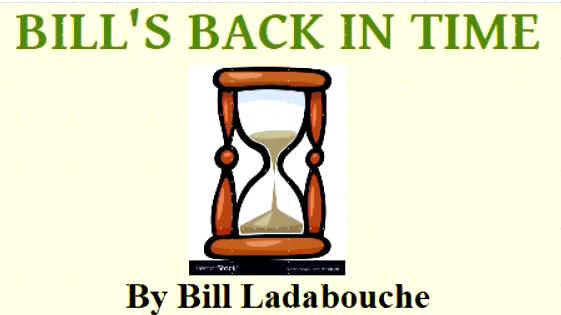
BILL'S
[Somewhat] WEEKLY COLUMN/BLOG PAGE

A TIP OF
THE HAT TO AN AMAZING RACE FACILITY
There are dozens of men who know more about the history of Lebanon Valley Speedway than I do; so, this is no attempt at any sort of comprehensive history. Firstly, it's only about the earlier portion of the speedway's rich life, and secondly, it is more my way of giving it the attention it so richly deserves as an important facet of the history of stock car racing in the Northeast.
To me, the Valley was important because 1.) the organization came and staged a program at the Vermont State Fairgrounds in Rutland in 1961 at a time when we were starved for any racing to see in our area; 2.) the Valley supplied a number of interesting and important competitors for both the earlier Fairmont Speedway and later Devil's Bowl Speedway of C.J. Richards. Early hero Butch Jelley and later racing friend Don Ackner were both Valley guys.
Both Photos Courtesy of Dan Ody
These two familiar old photos of what
the Spanier barns looked like
as you arrived at the entrance to the Lebanon Valley Speedway in
earlier days.
I fully credit most of the track historical information to people like Jim Moffatt, Uncle Art Stuarts, and later historians like Chas Hertica for the factual info because I only got to see Lebanon Valley racing about twice or three times in my life. I picked up a lot of my limited knowledge from items these guys and others wrote.
The track was built on land owned by the Spanier brothers of New Lebanon, NY. It was first created by “two guys from Pittsfield, MA [which is, for those of you who aren't familiar – very close geographically to that corner of New York where it, Massachusetts, and Vermont all meet.; It was a great choice for that reason. The original track layout, lacking the famous banked turns of later years, was not well run or maintained. Rumor has it they had to cancel the first program because the track surface was so bad. The operation folded by 1954, while tracks like Fonda were taking wing.
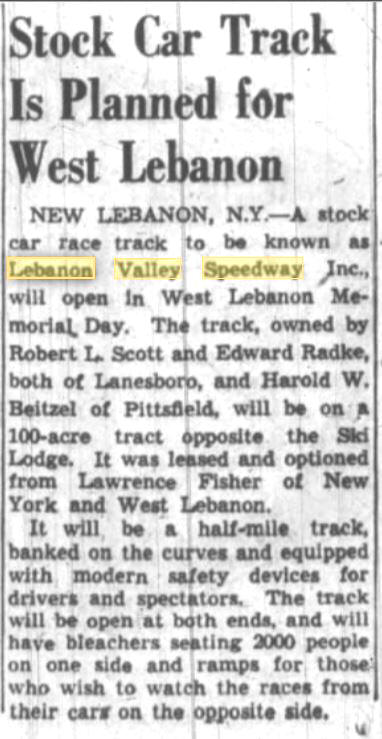
Berkshire Eagle
This January 1953 article in a
Massachusetts paper beacks up
some of the Scott recollections and refutes some others. Below -
An early advertisement for the new track whoever owned it.
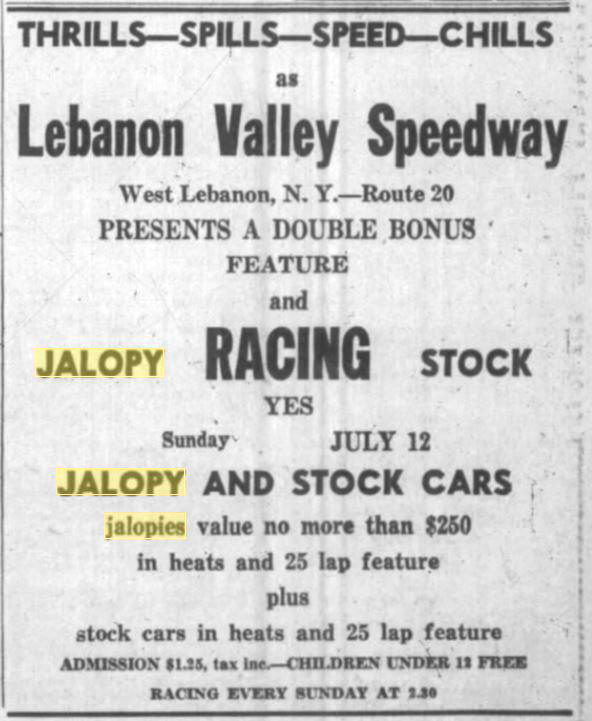
Berkshire Eagle
According to Scott, his father, Bob Scott, Sr. - a Pittsfield, MA area man – had been working a while at General Electric in the area after having made money for a while running bootleg liquor. Somewhat of a renaissance man, Scott also had a four – piece band and was an accomplished welder. Becoming increasingly interested in stock car racing, he was no longer satisfied to watch racing at places like Burden Lake Speedway. Once Scott had secured some financial backing from area men named Larry Dupree and Angelo DeGiuliio he determined the site on the Spanier farm was perfect, owing to its closeness to Massachusetts, as well as Vermont.
Scott writes: “Back in about 1952, after finding the track location, he began looking into the permits and politics for constructing a track. Massachusetts was out because of the stiff regulations and their associated cost, Vermont had no locations available that would work, so New York was the place and fairly close to home. There were many hurtles to overcome regardless. He still had to find backers to finance it, a contractor to build it, enter into the local racing community to get cars to race, etc. He worked hard for the next year and the track opened in 1953, I believe in June.
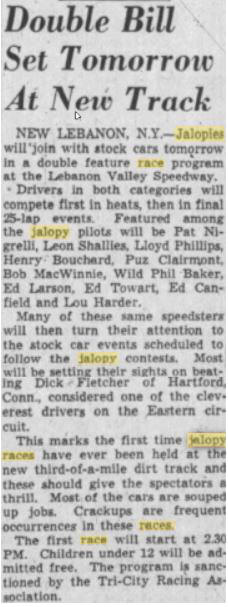
Berkshire Eagle
This hopeful article
put out in Scott's local paper The Berkshire
Eagle could not foresee the problems with the track surface
that would develop. It was a lot of un familar names. I think
"Lou Harder" was mostly likely the great Lou Hacker.
Below – A photo of what I assume is the first feature field
at the Valley in 1953. The car on the inside pole could be Hacker.
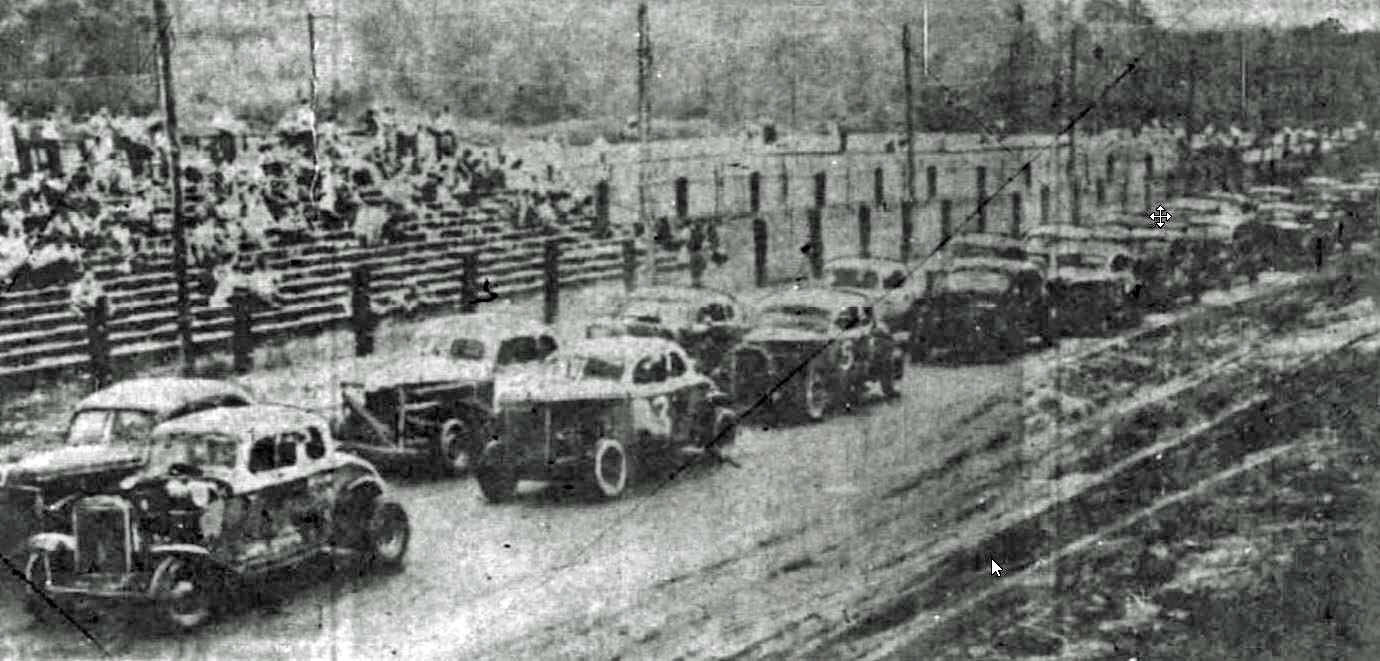
Berkshire Eagle
Once he got his two backers, (Larry Dupee, Angelo DeGiulio, ) I have no idea what kind of deal he cut with them or how. I was only 11 years old then. When I first saw them, they looked like gangsters to me, but apparently all was good, no problem. Then with the necessary permits and paperwork the track was ready to start construction. However, there were never any drawings just my dad's concept. So in late 1952, armed with a 100 foot tape measure, tomato sticks and white twine, we went over on a Saturday to layout the track. It was to be a flat 1/2 mile around the in-field, with pits in the center and grandstands on the route 20 side. There was a problem fitting that size track in the farm field toward the west end. “
The Scott version certainly could do a lot to fill in the “two guys from Pittsfield” void in information. Scott went on to write: “Locating the track farther east was limited by the need for spectator parking, so it had to be placed between the route 20 easement and the railroad easement (at the time, the railroad ran where the drag strip is now). The problem was solved by reducing the radius of turns 3 and 4 by 50 feet. That change still shows in the aerial photos today. The drivers noticed that turns 3 & 4 were tighter than 1 & 2. Once the layout was complete, he hired a small contractor out of Lanesboro, Leo Fontain, who did the excavation and damn near screwed it up by taking too much soil from turn 1. Then he hired other various small contractors to build fences, bleachers, concession stands, restrooms etc. all complying with the pertinent codes.
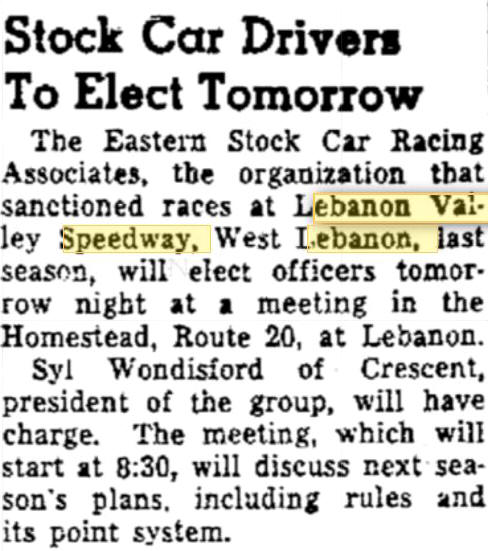
Troy Times Record
By the second year,
the drivers had organized. This was not uncommon in that era. Below - Even early
on, Lebanon
Valley was putting some large ads with bold claims in the Troy Times Record and
other papers.
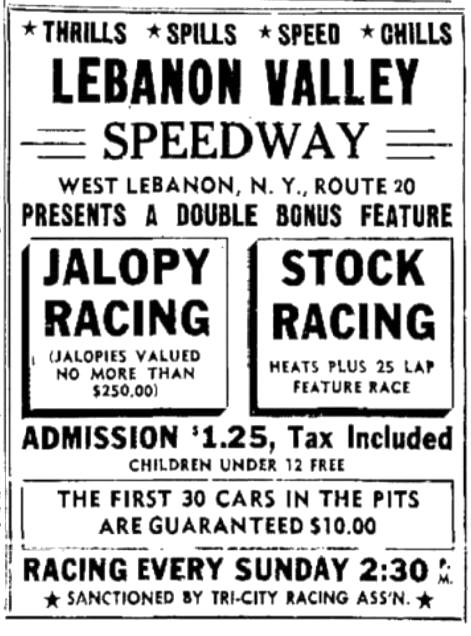
Troy Times Record
He supervised all this himself
mostly by checking weekends as he had a full time job at GE. There was so much
detail; from advertising posters, concession stands, tickets, news photos, down
to race trophies, he had a hand in all of it. He was very concerned about
spectator safety and their enjoyment, tickets were a dollar, kids 50 cents.
There was always an ambulance on site staffed with a nurse for drivers and
spectators. I can't remember if there was a fire truck on stand by.
Opening day in 1953 was rained out but the following week it went off with a bang. There were two issues to overcome; the dust was overwhelming and there were several holes dug out as the races proceeded especially in turn 1 where the contractor had erred. It took the remainder of the first season to get control of the dust and holes. Opening of the track for the 1954 season found a track well oiled similar to the local short tracks. The oil was trucked out of General Electric in Pittsfield from their waste transformer oil pit. I imagine that all the surface dirt has now been gone for many years as oil is no longer used to hold the dust. Either in 1954 or 55 Dad contacted NASCAR in an attempt to get them to sanction the track but they had no interest. I don't know if the track has a sanctioning body now or not.
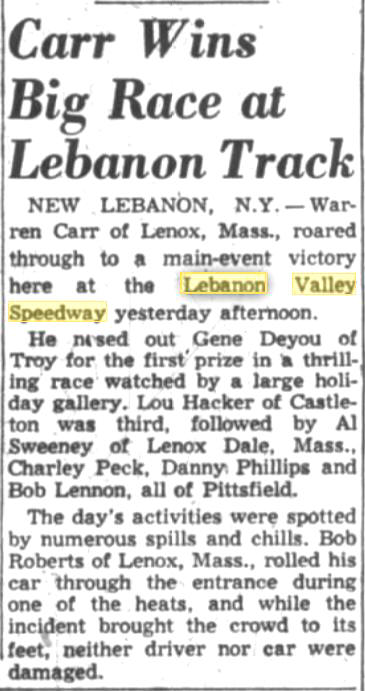
Berkshire Eagle
One of the winners on the improved, oiled track was Warney
Carr, a popular early runner at the Valley out of Lennox, MA.
Below – One of the few photos I could find of the Warney
Carr entry.
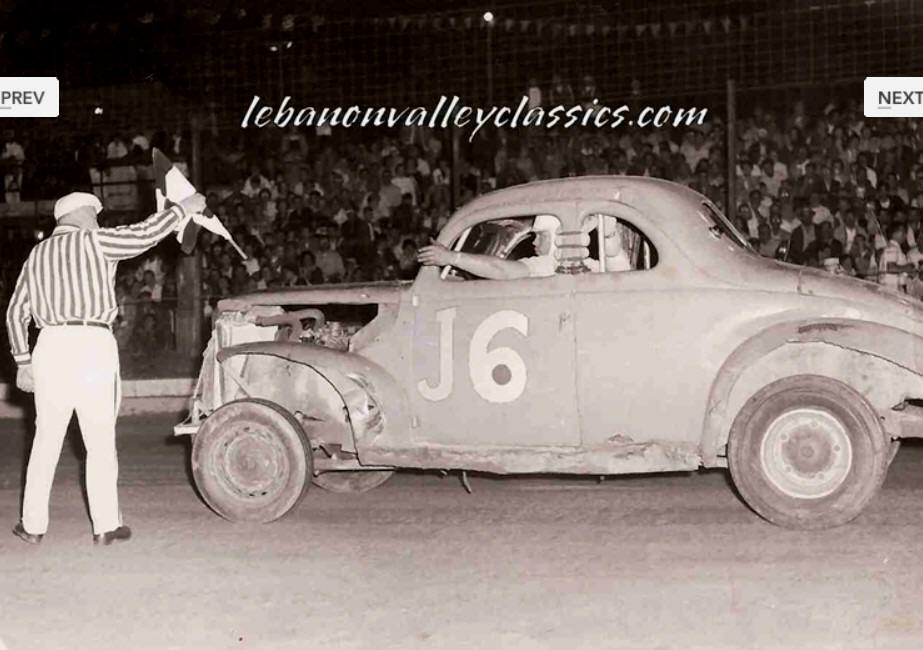
Lebanon Valley Classics
The 1955 season was dubious. Dad's two backers pulled out and he had to locate a replacement. Lou Spanier the farm owner stepped in to fill the void and the track opened on time including the addition of more bleacher seats. Dad managed the track that season as Spanier gained knowledge about the operating the track and racing in general. At the seasons end, my dad was no longer needed at the track and his dream came to an end. Since then the track with sufficient financing and a lot more work has been successful.”
I could gone through and paraphased it all; but, Scott, Jr. did a good job of telling the story which picks up in the next papragraph with the track lying dormant. There is a discrepancy with years, but I cannot know enough to clear that up.
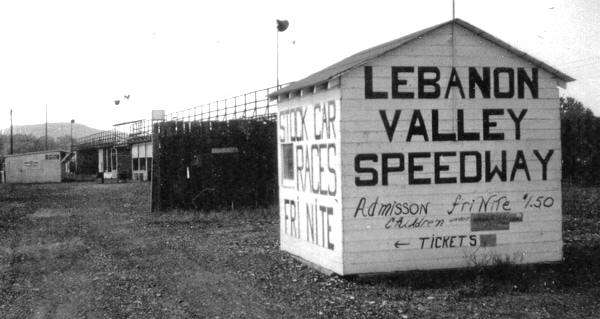
Courtesy of Lew Boyd
The old entrance sign that would
greet you at early
Spanier race programs. Below – The 1961 driver
gallery for Jim Moffatt's Cavalcade of Auto Racing
shows a lot of the old guard who left by the end
of that decade.
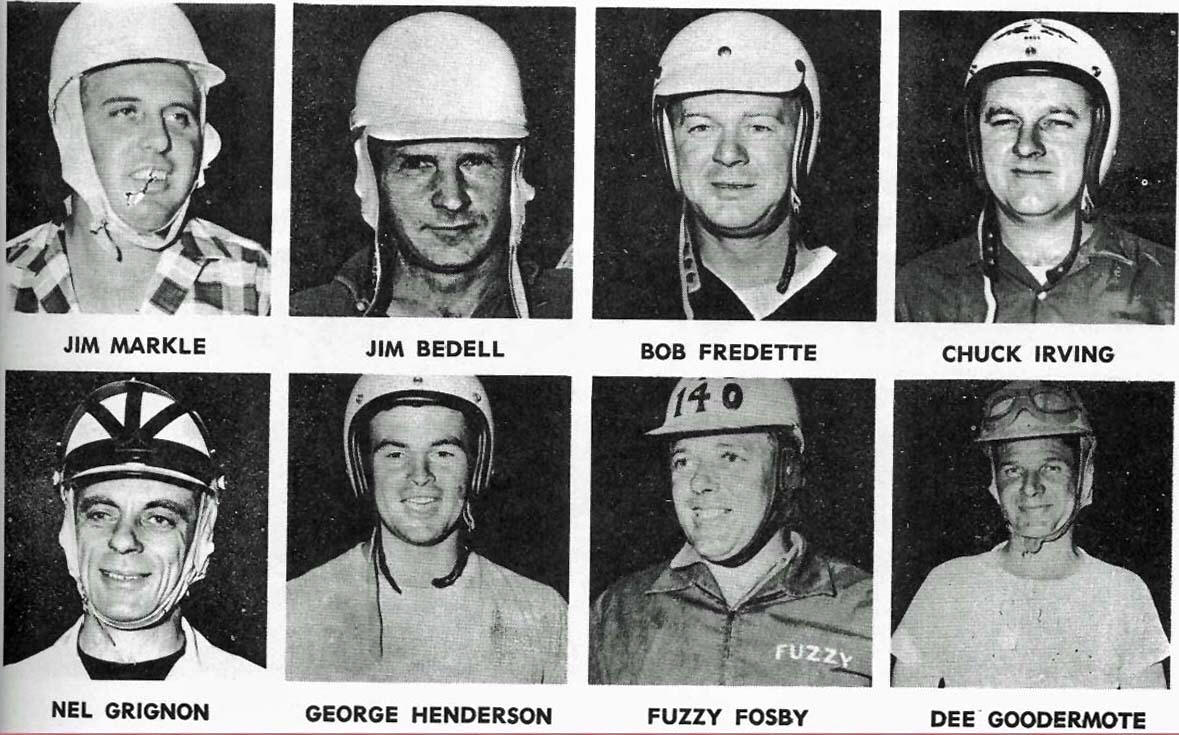
From Cavalcade of Auto
Racing
Not
originally interested in race promotion, Lou and Harry Spanier kept looking
across the road from their home at the dormant track, thinking about if it had
potential. They finally decided to use some of their expertise and some from
associates to improve the infrastructure which apparently included creating
those famous high banks. After letting “the two guys from Pittsfield” have a
crack a promoting the improved venue, the Spaniers eventually took it over and
the everything took off from there.
With promotional help from Oilzum's Jim Moffatt, the track soon was paying the best purses in the region and attracting dozens of non – NASCAR stock car teams. By the 1960's it was a clear rival to, and alternative to – the NASCAR – sanctioned Fonda Speedway. Sometimes cars from both tracks would clash at the understated Victoria Speedway near Dunnsville, NY [with the Fonda teams having to come up with “racing names” and alternative numbers to keep the highly – autocratic NASCAR from fining them every week.
Source of Both Photos Unknown
These shots featuring Henry
Bouchard [above center] and African
American racing pioneer Bo Green [0 below] show the early
Valley track with no banking.
The Valley had a personality of its own. The high banks, arguably the best fan food in the area, the local drivers' reputation for resenting and pounding on “outsiders” who occasionally invaded, and – lastly – its famed high – paying shows such as the Valley 200 and the open shows that both came about in the 1960's. Two of my visits to the track were to watch open shows. I really Rich Ricci leading one race for most of the time and that Mike Zopp won one of them. I was fairly familiar with the Valley regulars' names but the Zopps, the Ricci's, and the rest of the open cars were not so familiar.
Back in Rutland County, before I got off the college and subsequently to work far away, we first saw Valley action when, for some reason, the Spaniers decided to stage a race at the September fair in Rutland. The old horse track was horse sh--, as far as good racing went, and Butch Jelley always insists the outcome was pre-planned for safety reasons. I know seeing the likes of Martin Riiska's yellow X, Bucch Jelley's Y, Doug Garrison, Stretch Van Steenberg, Howie Westervelt, Rebel Harris, Bill Webb, Joe Messina, and so many more.
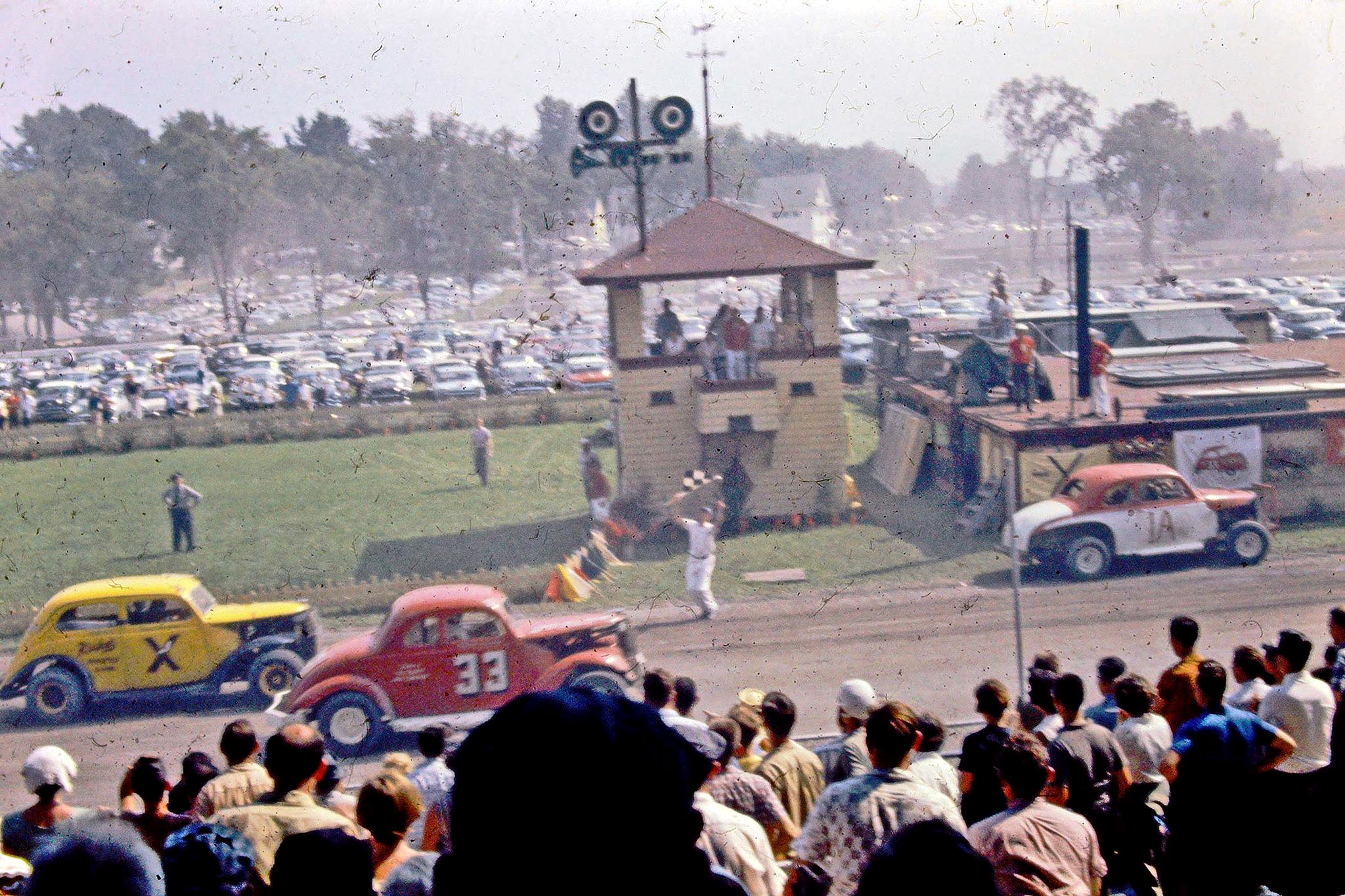
Unknown Source
While Bill Webb's 33 was the most
photographed and documented
car at the 1961 Rutland Fair show; but Joe Messina and the
Molitor #13 Hudson was the declared winner that day. Joe
would become more of a local fixture at the end of the
decade driving for the Tremonts at Devil's Bowl.
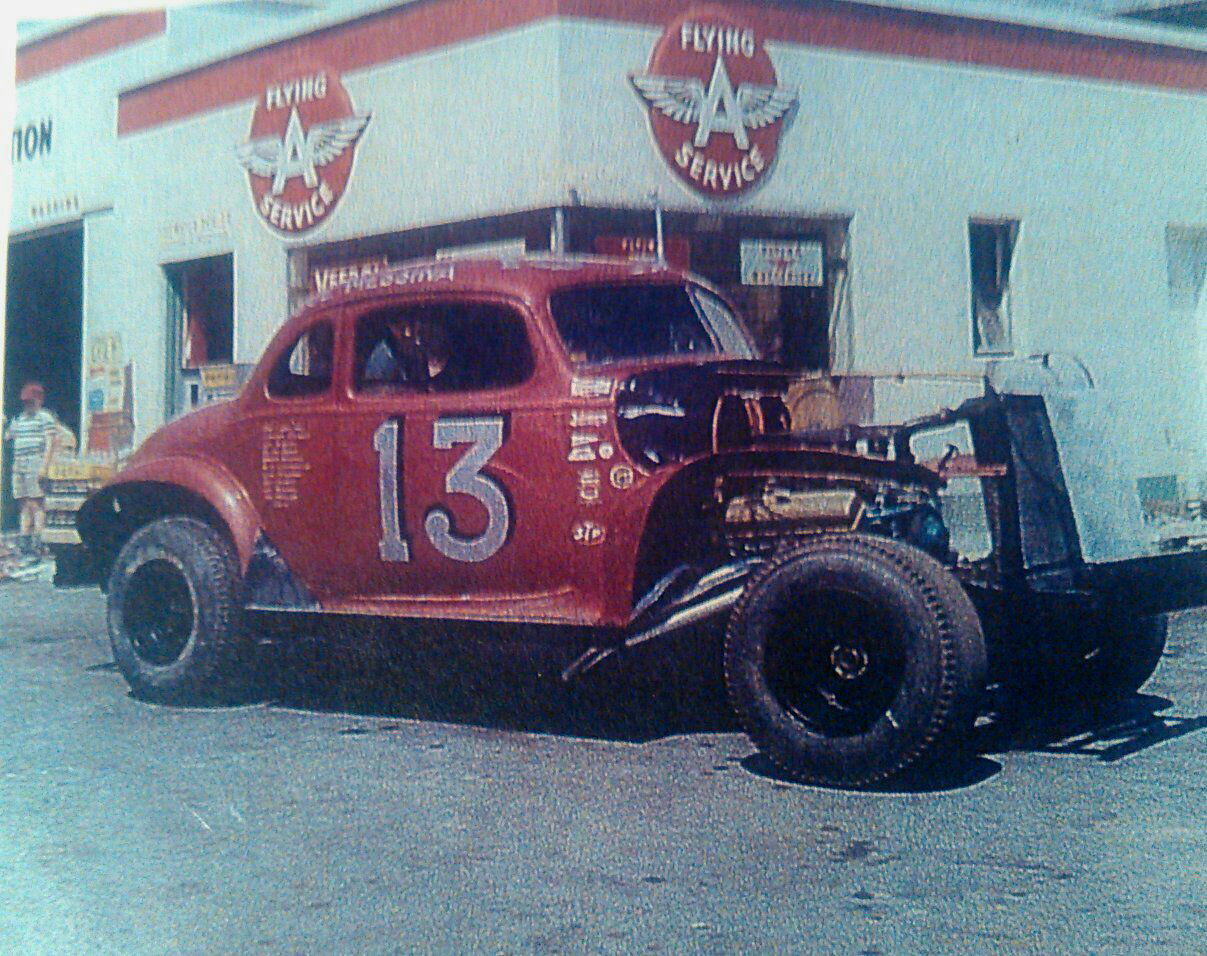
Courtesy of Sam
Barlow
In keeping with that Valley attitude, when Sonny Rabideau showed up with a cutdown, ultra light Claremont Speedway car, he was summarily dumped, ending up under the old rail fence in turn one, mere feet away from the propane tanks of Roxie's French Fry stand. There are few photos of that day, although it is mentioned in the Uncle Art Stuarts book that came out in the 1960's as a win for Joe Messina. I have always believed that the catalyst behind this one – time “away game” for the Valley cars was a young C. J. Richards, who had plans to open his own track nearby a year later. C.J. was always three steps ahead, like a chess master.
Between the big payoffs, the open shows, the chafing of certain teams under the smothering rule of NASCAR, and the appeal of high speed racing, Lebanon Valley began to steal drivers from other tracks – particularly Fonda. It started with a few small teams like the Pop Wilcox 32 , out of New Berlin and the Tom Chewins 108 team from Catskill. After a fashion, the likes of Bill Wimble and the Dave McCredy 33 team, Pete Corey with his own team, and Jack Farquhar with the Vince Barbuto team were some of the former Fonda regulars now racing at the Valley. Corey seemed to take the brunt of the resentment of the locals, often taking his beautiful yellow cars home in a basket.
Courtesy of Norm Vadnais
An ironic photo from the 1962 Stock
car race program at the same fairgrounds
shows Vic Love wedged in the fence at exactly the same spot in which Rabideau
had found
himself a year before. To add to the irony, Rabideau won this particular race in
the same car.
[Below] Butch Jelley ran this exact car at the 1961 Valley fair show and
at the opening program at
C.J. Richards' Fairmont Speedway in 1962.
Calvacade of Auto Racing Photo
Devil's Bowl Speedway, the descendant of Fairmont Speedway, benefited greatly from a strong interest that Valley drivers held in racing there on Sunday nights. The Bowl was a regular stopping off place for names like the Ken Tremont 115 team, Barry Purdy, Ray Chapman, Butch Jelley with Martin Riiska's X, and others. They soon began to bump into Fonda teams, like it had been at Victoria years before. Also, Bowl teams like Vince Quenneville, Sr and Ed Foley- as well as others like Al Ryan's 28 were running the Valley every week.
The cars became more sophisticated and faster. The open shows eventually fell by the wayside. Like everywhere else, the Valley began to lose some of its original stars, whose names were indelibly etched into the character of the place. Doug Garrison, Fred Searing, George Gowie, Howie Westervelt, and many others reached the age where they would retire. Others, like Stretch Van Steenberg, seemed to race until they were about 100. Jelley and Joe Messina were others who forged on. The track was developing new star names like the driver/sign painter/ photographer Chuck Ely [brother – in – law of Butch Jelley]; Don Ackner and West Sand Lake neighbor Ken Tremont; Lou Hacker, and many others hung up the helmet.
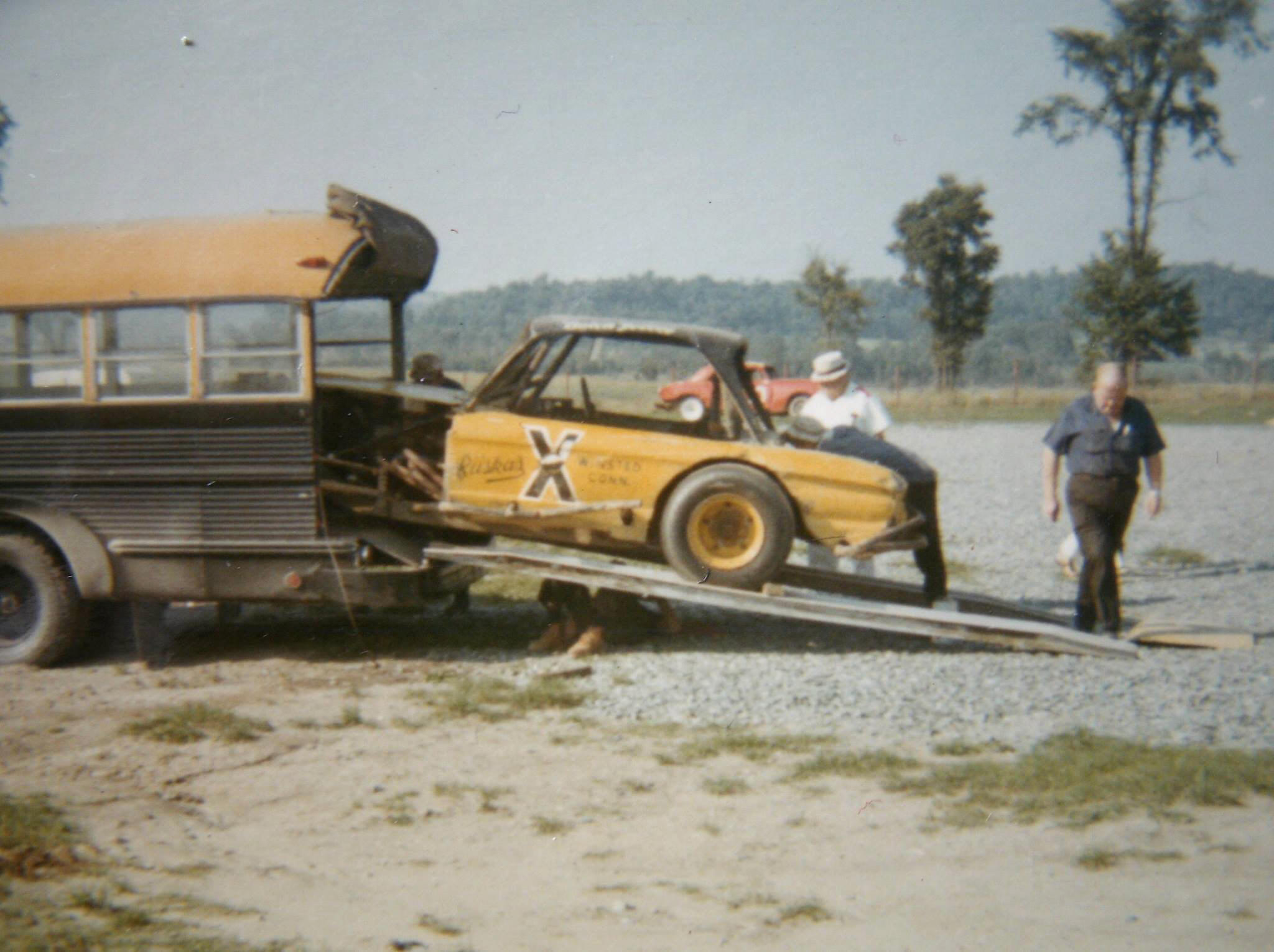
Cliff Haynes Photo
Teams and drivers we saw at the
Rutland Fair show in 1961 would re-appear at Devil's Bowl in the late '60's,
but in different combinations. Above – Butch Jelley, now with the Martin Riiska
yellow X is seen
unloading at the Bowl with Riiska walking by the ramps. Below – Joe Messina
ran the Tremont 115 at the Bowl for a few years before giving way to Chuck Ely.
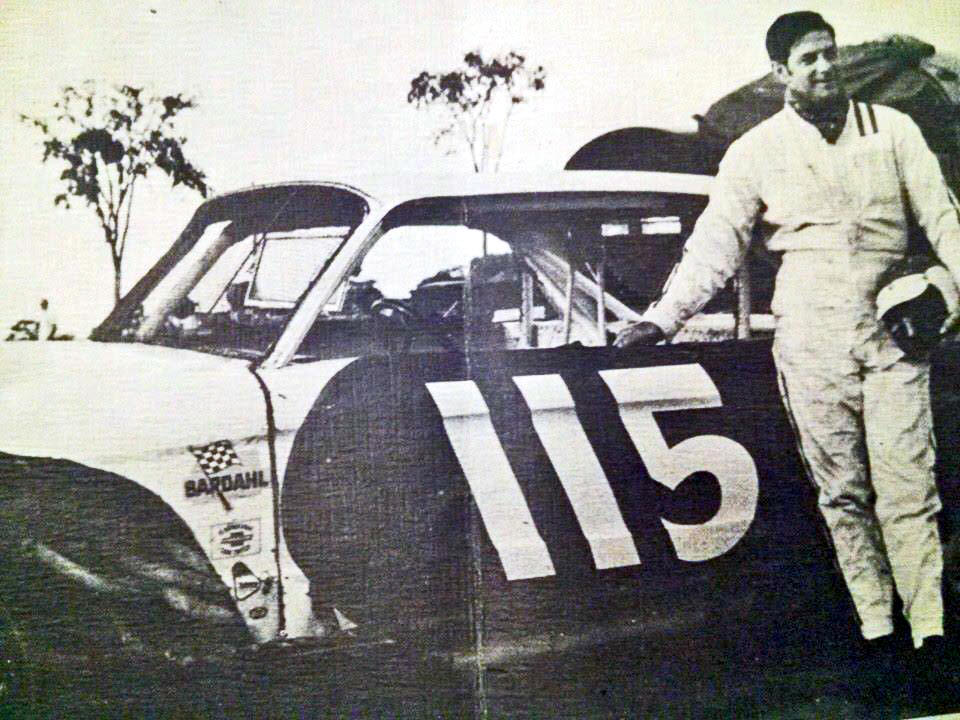
Bob Frazier Photo Courtesy of Mike Bruno
The length of the speedway and the high banks lent to speeds not seen at too many other tracks besides perhaps Thompson and a few others. Some Vermont drivers who did want to venture down there and give it a try did OK, like Vince Quenneville, Sr. Others did not. Northern Vermont legend Beaver Dragon talks of taking his Ernie – Preiss – built Falcon down to try a run on the dirt. What he described was how the long track and the banking was almost like seductive, tempting him to run faster and faster until he finally overdid and wrecked the car permanently [and that was their Catamount car]. There are also photos of Vermonters like Devil's Bowl's Jay Brown, on the hook at the Valley.
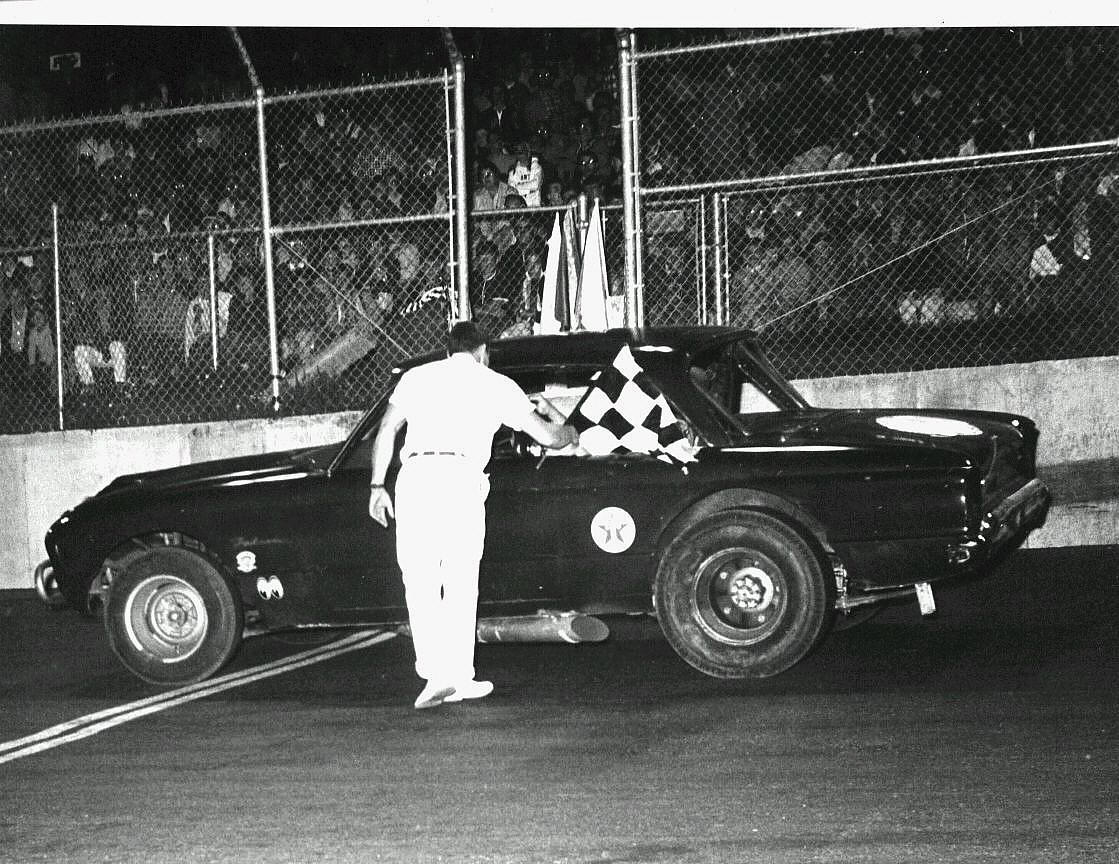
Dragon Family Photo
Beaver Dragon wins a heat at Catamount
with the Falcon his
friend, Ernie Preiss [from the Valley region] had built. Below -
Fellow D Bowl driver Graham Trudo ironically brought a
Falcon belonging to C.J. Richards to Catamount and
also wrecked the hell out of it.
Courtesy of Barb Laduc
At some point of which I am not certain, the Spaniers turned over the reins of the track to Howie Commander.. The track would improve its infrastructure and – as they entered the 1980's, the cars started to evolve towards the manufactured modifieds of today. Always having a good healthy second [late model] division, Lebanon Valley would eventually be known for having a large number of graduated support classes. Then, too, having begun back later in the 1960's, there was the Lebanon Valley drag strip.
The operational juggernaut that is the Valley continues on today, with a part of it being the ridiculously – successful Albany – Saratoga track in Malta. When Malta first opened in 1965, it was paved and had very little if any relationship with the Valley; but, the track is now dirt [again] and attracting huge fields and crowds on Friday nights. It's a remarkable operation - the Valley, and it was particularly unique and special in those early days.
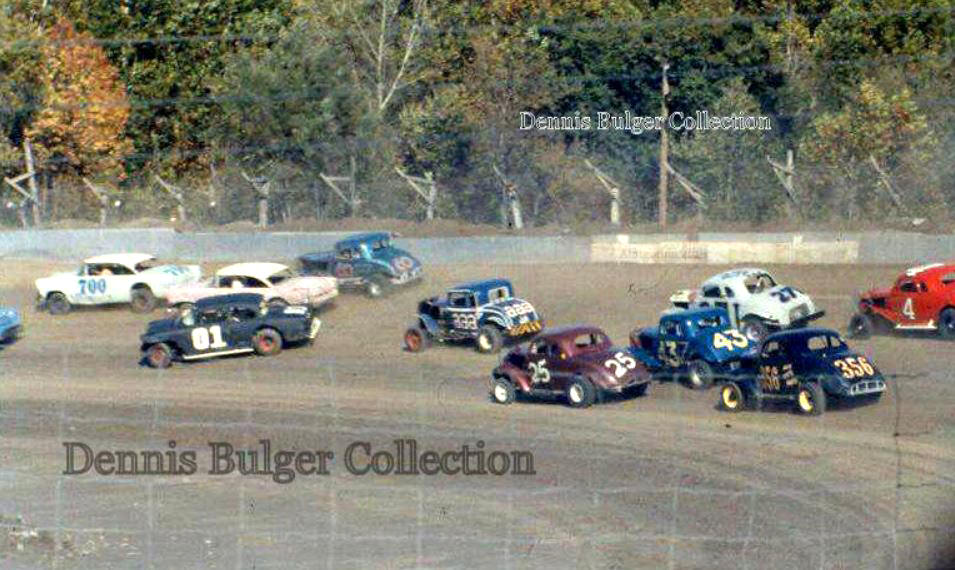
Dennis Bulger Collection via Chas Hertica
A good valley shot of their first open
program. There is
a mixture of locals and invaders. I can id aaa, Rebel Harris,
with Danny Mitchell in Harris' former ride ahead [the pinkish
Ford late model]. Ray “Zero” Brown in the Krueger 356 is an
invader. The 4 could possibly be Big Ed Patnode [or Bob Rossell].
Please email me at wladabou@comcast.net if you have any photos to lend me or information and corrections I could benefit from. Please do not submit anything you are not willing to allow me to use on my website - and thanks. For those who still don’t like computers - my regular address is: Bill Ladabouche, 23 York Street, Swanton, Vermont 05488.
AS ALWAYS, DON’T FORGET TO CHECK OUT THE
REST OF MY WEBSITE:
www.catamountstadium.com
Return to the Main Page
Return to the Main News Page
Return to the All Links Page
Return to the Weekly Blog Links Page